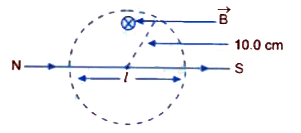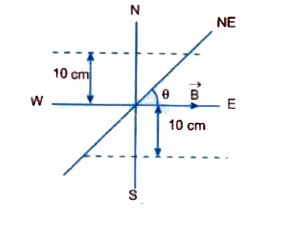A uniform magnetic field of 1.5 T exists in a cylindrical region of radius 10.0 cm, its direction parallel to the axis along east to west. A wire carrying current of 7.0 A in the north to south direction passes through this region. What is the magnitude and direction of the force on the wire if,
(a) the wire intersects the axis,
(b) the wire in the N - S to northest - northwest direction.
(c) the wire in the N-S direction is lowered from hte axis by a distance of 6.0 cm ?
(a) It is given that is present in a cylindircal region of radius r = 10.0 cm along east to west. It has been shown in fig. by sing , assuming east to west into the plane of paper. The wire carrying current I = 7.0 A is placed perpendicular to the magnetic axis along north (N) to south (S) direction. Then ,
Since acts along east to west and is in north to south, the force is in direction , ie., vertically downwards direction.

(b) As shown in fig, now the length of the wire inside the magnetic field is cm. The magnitude of the force is
The force acts in vertically downward direction.

(c) When the wire is lowered from the axis by a distance of 6 cm, as shown in fig., the length of the wire inside the magnetic field is
The magnitude of the magnetic force on the wire is

Topper's Solved these Questions
- MOVING CHARGES AND MAGNETISM BOOK - U-LIKE SERIESCHAPTER - MOVING CHARGES AND MAGNETISM EXERCISE - CASE BASED/SOURCE-BASED INTEGRATED QUESTIONS
18 Videos
- MOVING CHARGES AND MAGNETISM BOOK - U-LIKE SERIESCHAPTER - MOVING CHARGES AND MAGNETISM EXERCISE - MULTIPLE CHOICE QUESTIONS
35 Videos
- MOVING CHARGES AND MAGNETISM BOOK - U-LIKE SERIESCHAPTER - MOVING CHARGES AND MAGNETISM EXERCISE - SELF ASSESSMENT TEST (SECTION D)
1 Videos
- MODEL TEST PAPER 3 (UNSOLVED)BOOK - U-LIKE SERIESCHAPTER - MODEL TEST PAPER 3 (UNSOLVED)EXERCISE - SECTION A
3 Videos
- NUCLEIBOOK - U-LIKE SERIESCHAPTER - NUCLEIEXERCISE - Self Assessment Test
10 Videos
Similar Questions
A uniform magnetic field of 1⋅5T is in cylindrical region of radius 10⋅0cm with its direction parallel to the axis along east to west. A wire carrying current of 7⋅0A in the north to south direction passes through this region. What is the magnitude and direction of the force on the wire if (a) the wire intersects the axes, (b) the wire is turned from N-S to north east-south west direction, (c) the wire in the N-S direction is lowered from the axis by a distance 6⋅0cm?
View SolutionA uniform magnetic field of 1.5T exists in a cylinderical region of radius 10.0 cm, its direction being parallel to the axis along east to west. A current carrying wire in north-south direction passes through this region. The wire intersects the axis and experience a force of 1.2N downwards. If the wire is turned from north south to northest-southwest direction. then magnitude and direction of force is
View Solution
Knowledge Check
A uniform magnetic field of 1.5T exists in a cylindrical region of radius 10.0 cm, its direction being parallel to the axis along east to west. A current carrying wire in north-south direction passes through this region. The wire intersects the axis and experience a force of 1.2N downwards. If the wire is turned from north south to northest-southwest direction. then magnitude and direction of force is
A1.2 N, upwardB1.2√2, downwardC1.2N, downwardD1.2√2N, downwardA wire carries current toward the north. In the region beneath this wire, What is the direction of the magnetic field due to the current ?
ANorthwardBSouthwardCEastwardDWestwardA long straight wire in the horizontal plane carries as curret of 75 A in north to south direction, magnitude and direction of field B at a point 3 m east of the wire is
A4×10−6T, vertical upB5×10−6T, vertical downC5×10−6T, vertical upD4×10−6T, vertical down
50 A current in north to south direction. Give the magnitude and direction of →B at a point2.5 m east of the wire.
View SolutionA magnetic field of strength 1.0 T is produced by a strong electromagnet in a cylindrical region of radius 4.0 cm as shown in . A wire, carrying a current of 2.0 A, is placed perpendiuclar to and intersecting the axis of the cylindreical region. Find the magnitude of the force acting on the wire.

View SolutionA magnetic field of strength 1.0 T is produced by a strong electromagnet in a cylindrical region of radius 4.0 cm as shown in . A wire, carrying a current of 2.0 A, is placed perpendiuclar to and intersecting the axis of the cylindreical region. Find the magnitude of the force acting on the wire.

View SolutionA long straight wire in the horizontal plane carries as curret of 75 A in north to south direction, magnitude and direction of field B at a point 3 m east of the wire is
View SolutionA current carrying wire is placed along east and west in a magnetic field directed north wards. If the current in the wire is directed east wards, the direction of force on the wire is
View Solution
